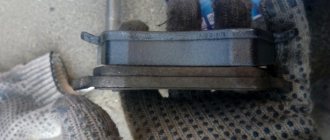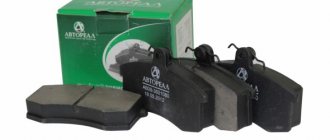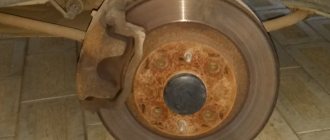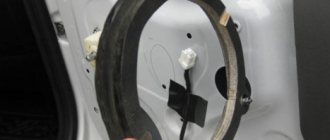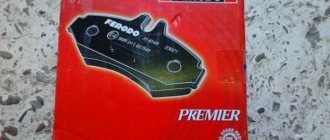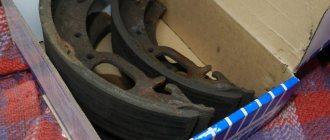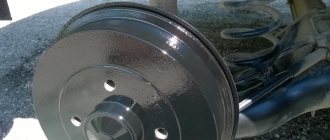Any car slows down due to the fact that the pads press the disc after pressing the brake pedal. The working brake system of a car is a complex mechanism. Front and rear pads for a Lada Vesta car are consumable spare parts that have their own resource and are only part of this mechanism. Vesta, by the way, is a car with good brakes. Because in inventive activities more attention is paid to brakes than to engine modernization - everything is done for the safety of the driver and passengers. Like all parts, the pads, especially the front ones, are not of good quality, sometimes they creak when they are cold. This is due to the quality of workmanship and not a perfect fit to the disk. Poor quality pads can quickly eat up the metal of the disc, or quickly wear out on their own. The braking distance must be minimized, even when the car is traveling at the “maximum” speed. The rear pads come in drum and front disc versions. Depending on the modification, Lada Vesta has both options. But which engine costs 1.6 or 1.8 does not affect the choice of pads at all - they are the same everywhere.
A large load when braking falls on the front pads of the car, which “catch” all the energy on themselves. Parts of the brake mechanisms (especially the front ones) wear out over time, and they wear out even faster if the driver has a jagged driving style with sharp braking to a complete stop. The front pads of the Lada Vesta are good enough to withstand full braking, but even they can be “upgraded”.
wear of the front pad in relation to the old one to the new one
The importance of the service braking system cannot be underestimated. The rear pads of the Lada Vesta experience considerable load when braking and eventually fail. The force with which a car brakes directly depends on the condition of the working brake system, including the rear pads.
RDT (Rear disc brakes) are available in the Lada Vesta SV Cross and Sport modifications. They provide greater braking effect and are more durable due to their design - they overheat less, but have a shorter service life. Drum brakes are available on other versions of the Lada Vesta; they are considered less effective when braking, but longer lasting.
Replacing rear brake pads is more difficult with a drum. The nut must be rotated carefully, otherwise the mechanism will be damaged. Combined with the care with which you have to handle the springs and small parts of the mechanism, you can say that the mechanism is rather weak, but in fact it has been tested over the years and boasts a long service life.
The rear drum mechanism with pads looks like this
Lada Vesta brake pads are recommended to be inspected after 15,000 km. According to the regulations, replacement is carried out after 60,000 km, but experts advise changing them at 30-45 thousand km.
- Standard front pads - article number and price
- What you need to replace brake pads
- Basic faults
- When to change pads on Lada Vesta according to regulations
- Removing and installing front pads
- What front brake pads can be installed on the Lada Vesta - manufacturers, analogue prices
- Rear brake pads Lada Vesta - replacement
- Replacement with calipers
- To replace the rear disc pads of the Lada Vesta you need
- How to change with drums
- What can you tell by the wear of the rear brake pads?
- Analogues on calipers and drums
Standard front pads - article number and price
On a Lada Vesta car of any modification and in any body, consumables manufactured by Renault are installed - be it a sw station wagon, sw cross, sport, etc. On the Lada Vesta St. Cross, the consumable parts can withstand the load - they wear out at the same rate as on other modifications.
Standard components of the Lada Vesta brake system received catalog number 8200 432 336. Their cost in stores starts at 1,400 rubles and ends at approximately 2,000 rubles.
The pads are frozen, the ABS signal is on - how to fix it
Most often, the PTC or ZTK jams after washing in cold weather or heavy snow accumulation under the brake system sensor. When the car starts, the control unit recognizes a sticking error and signals it with a yellow indicator on the dashboard.
It is quite easy to fix the defect on your own, repeat the following steps:
- Start the engine.
- Engage reverse gear.
- Increase the speed, back up a few meters.
- A similar distance forward.
The indicator on the dashboard should go out and the sensor should return to its original position. If the recommendations do not help, wash the PTC with a stream of warm water at a car wash, contact an authorized dealer to have the breakdown repaired.
Standard rear brake pads - article number and price
The article number for a set of original pads comes in two types – for drum and disc brakes. The catalog number of the kit for the VAZ Lada Vesta with disc brakes is 11196-3502089-00. It costs about 2000 rubles.
Drums
The kit catalog number for the version with drum brakes is 8450076668. It will cost 4,000 rubles, but, again, it will last longer.
Complete set with calipers
Disc brakes complete with calipers are not sold everywhere, but you can purchase additional calipers. Article - 11196350201100, cost - from 9000, produced by AvtoVAZ.
Basic faults
If we exclude the possible defective parts and poor quality from the manufacturer, then the main reason why the front pads on the Lada Vesta become unusable is wear. They actively interact with other parts of the brake mechanism, and therefore a look at the nature of damage to the friction linings will make it clear what is wrong with the operation of the brake system. By correcting this error, you will increase the service life of not only the pads, but also the entire mechanism.
The nature of the malfunctions can be noted:
- Uniform wear - it manifests itself in the fact that the friction layer is worn evenly, this shows that the brakes are working well.
- Severe wear of the friction layer, brake rivets are visible - this means that you have been using the “outdated” parts for too long. The rivets could damage the disc, so it would be a good idea to inspect it for damage.
- The friction layer is worn evenly around the entire circle, but one of the sides is worn out more than the other - one of the parts of the brake system (guide or piston) does not distribute the braking force correctly. Cleaning all “live” parts and applying a new layer of lubricant will help. Naturally, everything will have to change.
- Both components are worn unevenly, the surface is strewn with irregularities and roughness. The reason for this outcome is a malfunction of the caliper guide pins - they swing and do not give an even trajectory of movement. You will have to clean them, then reapply lubricant.
- The friction lining is cracked - in this case, the “trouble” is caused by the brake discs themselves - they wear unevenly. Everything will have to change.
- Uneven wear of the friction layer means that the parts were installed incorrectly. They will have to be changed.
After performing a visual inspection of the damage, you can independently make a verdict about the breakdown. And besides this, there are several other signs by which you can find out about a faulty front pad while sitting behind the wheel.
Creak
If a squeaking noise occurs from the front when braking, this means that the pad and disc are not mating. This happens when a cheap analogue was purchased to replace the original component. But not everything is so bad - sometimes this analogue can last a long time, but the real reason is dirt that has gotten into the moving parts and reduces the contact area of the moving parts.
Vibration at speed: what is it?
Vibration at speed appears when the pads do not fit the discs - there is some incompatibility that does not manifest itself in the operation of the “original” parts. If, when braking, you still get “full contact” of these parts of the brake mechanism, this means that the wear of the hub discs themselves is haunting, and they will have to be replaced.
Top 3. Renault 410608481R
Rating (2020): 3.97
- Nomination
The best combination of price and quality
Optimal performance characteristics and a fair price show the best ratio among these products for Lada Vesta.
- Characteristics Average price: 1510 rub.
- Country: France
- Thickness, mm: 17.3
- Wear warning indicator: yes
Front brake pads under article number 410608481R can be installed on a number of RENAULT and Lada models, for example, on Largus or Lada Vesta. The original spare part (the factory puts them on the assembly line) is distinguished by its quality and perfect fit. In practice, the pads prove to be wear-resistant and quiet. They brake excellently and work out their service life in full. Due to the average rigidity of the friction material and fine abrasiveness, the discs do not wear out. If you decide to replace the pads on your Lada Vesta or Renault Duster, this is the best option, according to buyers. The range of prices on the market indicates the presence of counterfeit products. The retail price of the kit is significantly less than 1,500 rubles and should be alarming.
Advantages and disadvantages
- European quality
- High braking efficiency
- No squeak
- Good work resource
Wide range of prices on the market
Removing and installing front pads
Before starting work, prepare the following tools:
- Keys for 13 and 15;
- Brake system parts cleaner (a regular rag will not be able to completely remove dirt and used lubricant residues);
- Flat screwdriver;
- High temperature grease.
The procedure for replacing parts is as follows:
- Secure the vehicle in place by applying the parking brake. Turn off the ignition. Raise the front of Vesta with a jack;
- Proceed to remove the wheel. Remove the cap, loosen the bolts one turn. Continue this action in a circle with all the bolts;
- Remove the brake fluid reservoir cap and pump out a few milliliters. This will prevent the liquid from coming under pressure. Press the brake cylinder inward with a screwdriver;
- Use a 15mm wrench to hold the caliper guide pin, and use a 13mm wrench to remove the two bolts. Do not let the free part of the caliper fall to the ground;
- Pry up the outer pad with a screwdriver and carefully remove it. In the same way, remove the inner block;
- The spring retainer, which is responsible for uniform wear, will have to be cleaned and then re-coated with lubricant;
- Install a new part - first the external one, then the internal one;
- Clean the guides and also coat them with lubricant;
- Put all the parts back;
- Tighten the fastening bolts, install the wheel, clockwise, one rotation at a time, secure all the bolts.
What front brake pads can be installed on the Lada Vesta - manufacturers, analogue prices
The following analogues of front pads are common:
- Front brake pads HI-Q Sangsin Brake (SP 1564) – 1400 rubles;
- SAT (ST4106000Q0K) – 450 rubles;
- Brembo (P68033) – 1600 rubles;
- Galfer (B1G10207412) – 1250 rubles;
- Zekkert (BS-1221) – 700 rubles;
- Blitz (BB0292) – 750 rubles;
- Hagen Sangsin Brake (GP 1564) – 1400 rubles;
- UBS (BP1105007) – 1500 rubles;
- ATE (13.0460-2709.2) – 1700 rubles;
- LYNXauto (BD5739) – 850 rubles;
- TRW (GDB 3332) – 1700 rubles.
Rear brake pads Lada Vesta - replacement
The moment to replace and repair the rear pads on a car is determined by the fact that they are in a state of maximum permissible wear. You should also start planning a replacement if the linings are oily, or if chips, cracks and damage are visible on them, as well as a gap between the base of the consumable and the lining.
It is important to understand that the consumables on the rear wheels need to be changed as a set - so that the force is uniform, otherwise the car may skid when braking, and the braking itself will be ineffective. You need to install all four parts.
The best front wheels for Lada Granta
When compiling a kind of rating, we studied reviews of owners, parameters, price and quality. Among the best analogues, four candidates can be distinguished.
Sport Alnas, from RUB 1,700. (21-12-350-1070-01)
Brake discs made of cast iron are characterized by a long service life. The parts quickly grind into mating elements and fit well into place. It is worth noting that the manufacturer's warranty does not apply to self-installation. Thickness – 18 mm, number of mounting slots – 4, weight – 12 kg. The owners consider the optimal combination of cost and quality indicators to be the main advantage.
Brembo Max, from RUB 2,800. (09-8903-75)
Discs from an Italian manufacturer show efficient operation, there are no beats or vibrations. The elements are easy to install. If there are unpleasant sounds after the replacement, do not be upset; after 2-3 days they disappear.
Brief characteristics:
- thickness (mm) – 18;
- mounting holes – 4 pcs.;
- centering (mm) – 58.5 mm;
- tightening torque – 75.
Bosch, from 1,500 rub. (098647-9346)
Budget discs that are not inferior in quality to expensive analogues. When braking, vibration moments and beating do not occur. The advantages of the devices include increased strength and durability. The products are made of cast iron (thickness is 18 mm, with a centering diameter of 58.5 mm). Good protection against counterfeiting, available at most points of sale.
ATE Power Disk, from RUB 3,500. (24.0120-0187/1-420187)
The best brake discs for the front wheels of Lada Granta cars are made in Germany. The advantages include increased strength, smooth and effective brake operation. These devices are resistant to temperature fluctuations, which is important for the harsh climate of Russia. Models made of high-carbon cast iron have thoughtful protection against the accumulation of a gas cushion between the discs and pads.
Options:
- minimum thickness – 23 mm;
- mounting sockets – 5 pcs.;
- weight – 8.3 kg;
- centering – 63.5 mm.
Replacement with calipers
Replacement with calipers is carried out in the same order, only at the stage when the entire mechanism is disassembled, using keys 13 and 15 you need to remove the caliper and put new parts in its place.
To replace rear disc pads on a Lada Vesta you need:
- Place the car on the ramp and lock it in gear;
- Bring the brake fluid level to a little less than half;
- Raise the rear of the machine and secure it with the support stand. Remove the wheel;
- Install the disc removal tool from the hub;
- Place the central part on the axle, and the rest will create pressure on the disk;
- If something won't come off, treat it with wd-40. Remove the bolt that secures the disc to the hub. Do this carefully, because if the edges of the bolt come off, it will be more difficult to remove;
- Remove the brake pads;
- Check the condition of the brake system. Put the new components in place and reassemble everything in reverse order;
- Bring the brake fluid level to about and adjust the brake pedal.
To replace the pads you will need the following tools:
Which pads are best to put on the vest?
- jack - a mechanism designed to lift loads standing on it, for example, a car;
- wheel bolt wrench - is a wrench suitable for working with wheel fasteners;
- slotted screwdriver - a tool for screwing or unscrewing fasteners with a straight slot, also called a “flat screwdriver”;
- A wire brush is a brush with wire bristles that will help with cleaning and removing rust. It is widely used not only in production or industry, but also at home;
- lubricant for guide pins;
- anti-squeak lubricant for the back side of the pads.
Useful and interesting A tricky way to restore and “revive” a car battery using simple home remedies
How to change with drums
You can remove the old ones and install new rear drum pads on the Lada Vesta using the following algorithm:
- Place the car on the overpass and turn off the handbrake. Secure the car by putting it in gear. It is better to reduce the brake fluid level and make it a little less than half of the norm.
- Raise the rear of the car slightly and secure it with a support stand. Remove the wheel.
- Using a flat-head screwdriver, rotate the ratchet nut away from you (“pushing” it along the thread). This reduces the length of the spacer bar and brings the pads together.
- Insert the chisel under the cap and use a hammer to knock down this cap protecting the drum bearing.
- Unscrew the hub bearing nut using a 30 mm socket.
- Carefully remove the brake drum along with the bearing. Notice the anti-lock brake sensor at the bottom under the ratchet nut (it looks like a small black plastic lever). Your task is not to damage it.
- Take a screwdriver, pry the release spring behind the hook, and then the stand. Take them off. Also remove everything on the front pad.
- Using the same screwdriver, pry the lower tension spring by the hook and remove it.
- Try not to damage the cylinder boots.
- Hook the upper tension spring on the hook and remove it from its engagement with the front block, and then dismantle it.
- Remove the front block and then the bar from the mechanism.
- Disconnect the end of the handbrake cable from the rear shoe lever.
- Before assembling the mechanism, the rear tip of the spacer bar must be recessed - the length of the spacer bar will be minimal.
- Brush the working surface of the drum with a wire brush to remove dust and dirt. Use the brush to avoid touching the ABS sensor reference ring.
- Install the mechanism in reverse order.
- Tighten the hub bearing nut to 175 Nm. As a recommendation, it is worth mentioning that it is better to install a new self-locking nut.
- After the work has been carried out, it is worth checking the brake fluid level in the reservoir.
- It is important to place the parts in the correct working position. Press the brake pedal several times and then hold it in the down position.
- Raise then release the handbrake (but only with the button engaged to deactivate the ratchet).
- Instead of handbrake clicks, you will hear other clicks - this is how the gap in the brake mechanism between the discs (drums) and pads is adjusted. Repeat these steps until the clicking noise disappears. If necessary, adjust the parking brake.
Which discs are better for Grants in different conditions?
Three different types of brake discs are installed on the Granta. Often users install similar parts from foreign cars to speed up the ride or to save money.
In the city and on the highway
Under normal operating conditions, factory cast iron discs or any other equivalents are suitable. If you have the original 13s and are not enough, change to a 14th size. It's easy to change them, and the car will brake much better.
Remember that you have an inexpensive sedan, not a race car. Do not overheat the brakes and if you drive through a water obstacle in the form of a puddle, dry them by briefly pressing the brake pedal. It doesn't make sense to pay more for ceramics for quiet use.
For lovers of fast driving
If you like to race, think about good brakes. For this purpose, 15-size perforated wheels with grooves or other sports wheels are suitable for the Granta. If you have a passion for this car and you are tuning it, install ceramics. Although it is expensive and needs to be warmed up, it is best suited for sports use.
Don't expect that having an ABS system will save you money on brakes. It prevents wheel locking, but does not improve braking performance in any way.
Off-road
If you want to try a front-wheel drive sedan as a trophy truck, then there is no point in thinking about good brakes. The speed will be comparable to a pedestrian, so you can install cheap brakes or leave standard (factory) ones if they are in good condition. If you're thinking of taking part in a rural rally at high speed, think about good wheels.
If the car is used for fast driving, do not skimp on the brakes. And it’s better not to drive. “Granta” is not intended for this, the security level is also low. The guarantee of your life is impeccable compliance with traffic rules. For fast driving, racing tracks have been built taking into account safety requirements. It is better to practice extreme driving on them.
What can you tell by the wear of the rear brake pads?
Pad wear means:
- Wear of the friction layer;
- Damage to the friction layer (for example, cracks);
- Friction layer bevel;
- Carbon deposits on the discs or drum.
These “illnesses” can appear when:
- Light knocking sound when braking. This should not be confused with ABS;
- Poor braking efficiency;
- Whistling, grinding noise when braking;
- Dust, chips on the discs.
Any car repair operation is a treatment. But a separate operation may not be a treatment, but a concealment of the symptoms of a real disease. If consumables are changed due to their “natural death” - the mileage mark has simply reached 60,000 km, then other parts of the mechanism clearly should not be blamed for this.
But if the consumables failed earlier, then replacing them may not solve the problem, and soon you may have to change not only them, but also other parts of the mechanism. This is due to another malfunction in the mechanism:
- Insufficient brake fluid level;
- Caliper malfunction (causes uneven wear of the friction layer), insufficient amount of lubricant or unsuitable lubricant;
- Faulty guides (for example, damaged boot);
- Incorrect adjustment of the service brake system, failure to release the handbrake;
- Low quality friction layer;
- Damage to oil seals;
- Depressurization (airing) of the mechanism;
- Uneven operation of hydraulic cylinders supplying unequal forces;
- Brake hose leak;
- ABS jamming;
- Warped brake disc.
Causes of Brake Wear
According to modern rules for monitoring the technical condition of vehicles, disc brake pads must be changed once every 10,000 kilometers. But this figure cannot be a single standard for everyone, since the wear of consumables greatly depends on driving style.
If you brake smoothly and not often (the mileage is mainly on the highway), then you can change the pads after 20,000 kilometers. On the contrary, if you brake frequently and sharply (aggressive driving style in the city), then the pads may wear off after 5,000 kilometers.
An important factor is the quality characteristics of the pads themselves. Some manufacturers openly save on raw materials. The same manufacturer may have several models of pads - more expensive and cheaper, softer and harder.
Everyone is different, so it is important to check your brake wear from time to time.
Analogues on calipers and drums
There are analogues for Lada Vesta drum brakes on the market:
- Fenox (BP53013). Cost 980 rubles; (BP53168) Price 1340 rubles;
- Hella Pagid (8DB355002-411). Price 2780 rubles;
- JP Group (1563900810). Price 1490 rubles;
- Mintex (MFR516). Price 2550 rubles;
- Patron (PSP8742). Price 730 rubles;
- Remsa (4137.00). Price 1110 rubles;
- Textar (91057300). Price 3130 rubles.
There is an analogue of Lada Vesta disc brakes. It is produced by TRW, article number gdb1384, cost – 1400 rubles.

